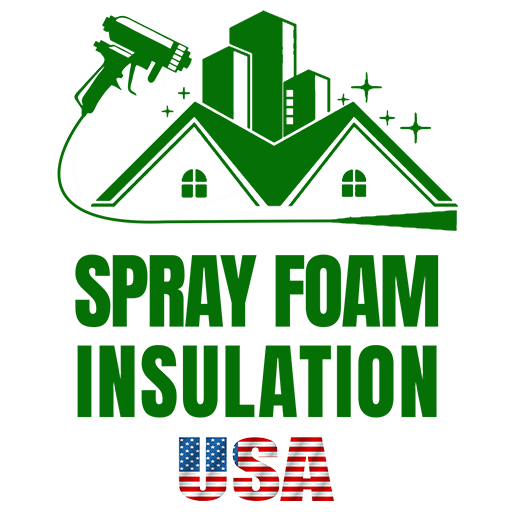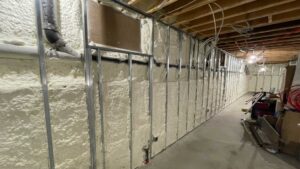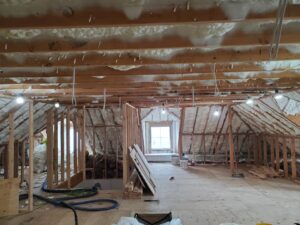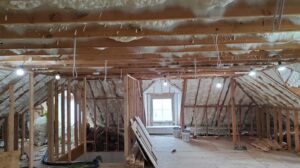Introduction
When it comes to enhancing your home’s energy efficiency, attic foam insulation stands out as a top solution. If you’re quickly looking to understand its importance, here’s the gist: attic foam insulation can drastically reduce your energy bills by creating an airtight seal that minimizes heat transfer and air leaks throughout the year.
- Immediate Effect: Reduces heating and cooling costs.
- Comfort Year-Round: Maintains stable indoor temperatures.
- Eco-Friendly: Lowers household carbon footprint.
This form of insulation is crucial not only for energy conservation but also for providing a comfortable living environment regardless of the season. Its ability to create an effective barrier against both heat loss in winter and heat gain in summer makes it a preferred choice for homeowners who prioritize efficiency and comfort.
Furthermore, the role of attic foam insulation goes beyond just thermal resistance; it also impacts your home’s overall air quality and moisture control, adding an extra layer of protection against mold and mildew.

Benefits of Spray Foam Insulation
When it comes to insulating your attic, choosing the right material can make all the difference. Attic foam insulation offers several key benefits that can enhance your home’s comfort and efficiency. Let’s explore these advantages:
Air Sealing
One of the standout features of spray foam insulation is its excellent air sealing capabilities. By creating a tight seal, spray foam prevents air leaks that typically occur in attics. This means less warm air escaping in the winter and less hot air entering during the summer, which can significantly improve your home’s energy efficiency.
Moisture Barrier
Spray foam insulation acts as an effective moisture barrier, protecting your attic from water and moisture ingress. This is particularly important in preventing mold growth and structural damage caused by moisture. Closed-cell spray foam is especially resistant to moisture, making it an ideal choice for areas prone to dampness.
Energy Savings
By providing both high R-value insulation and air sealing, spray foam can help reduce your energy bills. It minimizes the need for your heating and cooling systems to work overtime, leading to lower energy consumption. Homeowners often report up to 35% savings on their energy bills after installing spray foam insulation.
Longevity
Unlike other forms of insulation that can sag or settle over time, spray foam maintains its shape and effectiveness for years. Its durability means you won’t have to worry about replacing your insulation frequently, making it a cost-effective long-term investment for your home.
In conclusion, spray foam insulation offers a powerful combination of air sealing, moisture resistance, energy savings, and longevity. These benefits make it a compelling choice for homeowners looking to upgrade their attic insulation for improved comfort and efficiency. Next, we’ll delve into the different types of spray foam insulation to help you determine which option is best for your attic.
Types of Spray Foam Insulation
When choosing the right attic foam insulation, understand the differences between the two main types available: open-cell and closed-cell spray foam. Each type has unique properties and benefits that make it suitable for different attic conditions and homeowner needs.
Open-Cell Spray Foam
Open-cell spray foam is lighter and has a spongier texture. This type of foam expands greatly after application, filling nooks and crannies to create an effective air barrier. However, because its cells are not completely closed, it is more permeable to air and moisture compared to closed-cell foam.
- Pros:
- Excellent for soundproofing due to its soft, absorbent nature.
- Generally more affordable than closed-cell foam.
-
Good for applications where a high R-value per inch is not necessary.
-
Cons:
- Lower R-value (about 3.5 to 4 per inch), meaning it insulates less effectively per inch of thickness.
- Not recommended for areas prone to water leaks as it absorbs moisture more readily.
Closed-Cell Spray Foam
Closed-cell spray foam is denser and more compact. Its cells are completely closed, trapping gas and providing a high R-value (around 6 to 7 per inch). This type of foam is much less permeable to air and water vapor, making it an excellent choice for areas that require both insulation and a moisture barrier.
- Pros:
- Higher R-value provides better thermal resistance and reduces energy costs more effectively.
- Acts as a water vapor barrier, preventing moisture-related issues such as mold.
-
Adds structural strength to the roof or attic area due to its rigidity.
-
Cons:
- More expensive than open-cell foam.
- Heavier, which might be a consideration depending on the structural capabilities of your attic.
Polyurethane Foam
Both types of spray foams are primarily made from polyurethane, a material known for its durability and excellent insulating properties. Whether you choose open-cell or closed-cell, this material forms a continuous barrier that significantly enhances energy efficiency by eliminating air leaks.
R-value Comparison
The choice between open-cell and closed-cell foam should not be made on R-value alone. Consider other factors like your climate, the specific needs of your attic (e.g., are you also looking to prevent moisture?), and your budget. For example, in colder climates, the higher R-value of closed-cell foam might be necessary to effectively keep heat in. However, if you’re more concerned about soundproofing or have a limited budget, open-cell could be a better choice.
By understanding these differences, you can make a more informed decision about which type of attic foam insulation is right for your home. Next, we will explore the installation process for spray foam insulation, ensuring you know what to expect when you decide to upgrade your attic.
Installing Spray Foam Insulation in Attics
Installing attic foam insulation is a critical step in enhancing your home’s energy efficiency and comfort. Let’s break down the process into three key areas: Preparation, Process, and Safety measures.
Preparation
Before any spray foam is applied, thorough preparation is essential:
- Clear the Attic: Remove any old insulation, debris, or stored items. A clean surface is crucial for effective foam application.
- Seal Air Leaks: Identify and seal gaps around pipes, ducts, and light fixtures using caulk or foam. This step prevents thermal bridging and ensures maximum insulation efficiency.
- Check for Ventilation: Ensure that soffit vents are unobstructed to maintain proper attic ventilation, which is vital even after insulation.
Process
The installation process of spray foam insulation involves several steps that must be meticulously followed:
- Mixing the Foam: Spray foam components must be mixed according to manufacturer instructions. This ensures the chemical reaction needed to expand and cure the foam properly.
- Applying the Foam: Using professional spray equipment, the foam is applied to the attic surfaces, starting from the furthest point and moving towards the exit. Consistent thickness is key to avoid over or under-insulation.
- Curing Time: After application, the foam expands and cures into a solid cellular plastic that forms an air-sealing barrier. It typically takes 24 hours to fully cure.
Safety Measures
Safety cannot be overstated during the installation of spray foam insulation due to the chemicals involved:
- Personal Protective Equipment (PPE): Installers must wear suits, gloves, goggles, and respirators to protect against the inhalation of fumes and contact with the skin.
- Ventilation: Proper ventilation is crucial to expel off-gassing fumes from the attic. Use ventilation fans and ducts to direct these fumes outside the home.
- Avoiding Occupied Spaces: Ensure that the attic and surrounding areas are vacated during installation to prevent exposure to toxic fumes.
By following these detailed steps, you can ensure that your attic foam insulation is installed correctly, providing maximum comfort and energy efficiency for your home. Next, we will address common concerns and solutions associated with spray foam insulation, helping you manage any potential challenges post-installation.
Common Concerns and Solutions
When considering attic foam insulation, it’s natural to have questions and concerns. Here, we address the most common issues homeowners face, offering practical solutions to ensure your insulation project is successful and worry-free.
Odor Mitigation
Issue: Homeowners sometimes report a foul smell after the installation of spray foam insulation. This can occur if the foam isn’t mixed correctly on-site.
Solution: Choosing a reputable contractor who understands the precise chemical mixing required for spray foam is critical. Spray Foam Insulation USA ensures that all materials are accurately prepared and installed, minimizing the risk of odor.
Ventilation Needs
Issue: Proper ventilation is crucial when installing spray foam to avoid the buildup of toxic fumes.
Solution: During installation, use ventilation fans and flexible ducts to direct any off-gassing fumes outside the home. It’s essential to design a ventilation strategy that continues to manage air quality even after installation, maintaining a balance between airtight insulation and healthy indoor air.
Mold Prevention
Issue: With any insulation type, there’s a risk of moisture accumulation, which can lead to mold growth.
Solution: Spray foam acts as a moisture barrier, significantly reducing the risk of mold. However, it must be installed correctly to cover all potential gaps. Regular checks in the attic for any signs of moisture and addressing any leaks promptly are good practices.
Cost Considerations
Issue: The initial cost of installing spray foam insulation can be higher than other types of insulation.
Solution: While the upfront cost is indeed higher, the long-term savings on energy bills make it a cost-effective choice. Spray foam insulation provides superior air sealing and insulating properties, which reduces the need for heating and cooling, lowering energy costs over time.
By understanding and addressing these common concerns, homeowners can feel confident in their decision to choose attic foam insulation. The right approach not only enhances comfort and energy efficiency but also ensures the longevity and effectiveness of the insulation. Next, we’ll explore some of the most frequently asked questions about attic foam insulation to help you better understand its benefits and applications.
Frequently Asked Questions about Attic Foam Insulation
Is foam insulation good for attic?
Yes, foam insulation is excellent for attics. It provides a tight air seal, which can significantly reduce energy bills by keeping warm air out in the summer and in during the winter. This type of insulation is known for its high R-value, meaning it’s very effective at resisting heat flow. This makes your home more comfortable and energy-efficient year-round.
What is the downside to foam insulation?
While attic foam insulation offers many benefits, there are a few potential downsides to consider:
- Cost: Initially, foam insulation can be more expensive than traditional materials like fiberglass or cellulose. However, the energy savings over time often offset this higher upfront cost.
- Installation: It must be installed correctly to function effectively. Poor installation can lead to gaps or uneven coverage, which diminishes its insulating properties.
- Chemicals: Some types of foam insulation use chemicals that might emit volatile organic compounds (VOCs). However, opting for products with low VOC content can mitigate this issue.
Do you need attic ventilation with spray foam insulation?
This is a critical question and the answer depends on the type of foam insulation used:
- Open-cell foam is breathable, meaning it allows for some air movement in and out of the attic. This type can be used in attics where some ventilation is still desired.
- Closed-cell foam, however, creates a much tighter air seal, which can eliminate the need for traditional attic ventilation. This type is often used in climates where controlling moisture and reducing air leakage are priorities.
When switching to foam insulation, it’s crucial to consult with a professional who can assess your specific attic needs and recommend the best type of insulation and ventilation strategy. Proper balance between insulation and ventilation ensures the effectiveness of the insulation and the health of your home environment by preventing moisture buildup and related issues.
By understanding these aspects of attic foam insulation, homeowners can make informed decisions that lead to safer, more comfortable, and energy-efficient living spaces.
Conclusion
As we wrap up our discussion on attic foam insulation, it’s clear that choosing the right insulation is not just about improving energy efficiency—it’s about making a sustainable choice that benefits both your home and the environment.
Sustainability and Spray Foam Insulation
At Spray Foam Insulation USA, sustainability is at the core of what we do. Our spray foam products are designed to reduce energy consumption significantly. By sealing air leaks and providing excellent thermal resistance, spray foam insulation ensures that less energy is needed to heat or cool your home. This reduction in energy demand not only lowers your utility bills but also decreases your carbon footprint.
Moreover, we are committed to continuous improvement in our practices, staying up-to-date with the latest in green technology and sustainable materials. This commitment means that when you choose us for your attic insulation needs, you’re not just getting a service—you’re investing in a solution that will keep your home or business energy-efficient and eco-friendly for the long haul.
Why Choose Spray Foam Insulation USA?
Choosing Spray Foam Insulation USA means opting for a partner who understands the importance of both performance and environmental responsibility. We offer:
– High-quality materials that provide superior insulation and durability.
– Expert installation by licensed professionals who ensure that every job is done right.
– Innovative solutions that address both your immediate and long-term energy savings needs.
We believe that everyone deserves a comfortable, energy-efficient home, and we are here to help make that a reality for you. Whether you are looking to reduce your energy bills or make your home more environmentally friendly, our team is ready to assist you every step of the way.
Ready to make a change? Learn more about how we can help by visiting our attic insulation service page.
By investing in sustainable attic foam insulation, you are not only enhancing the comfort and efficiency of your living space but also contributing to a healthier planet. Let us help you take this step towards a more sustainable future.





